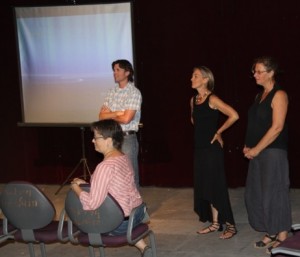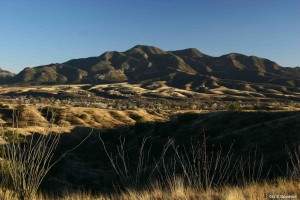Press Release
|
|
|
|
|
|


Filmmaker Ben Johnson, Director Kimi Eisele and Composer Vicki Brown fielding questions.
The Patagonia Area Resource Alliance hosted a reception and screening of ‘Rosemont Ours’ in Patagonia on Saturday, May 17. The evening began with a reception at Molly’s Studio Patio followed by a screening of “Rosemont Ours,” a film of modern dance celebrating the plants and animals of the Santa Rita Mountains. Filmmaker Ben Johnson, Director Kimi Eisele and Composer Vicki Brown were on hand to introduce the film and answer questions. “Rosemont Ours” was born in response to the proposed construction of the Rosemont Mine. By “replacing” plants and animals with human beings in reverential and playful ways, the film invited us to consider our role as both stewards and consumers of nature. “Rosemont Ours” can be viewed online: http://rosemontours.com/the-video/
PARA board member, Carolyn Shafer also spoke to the audience providing an update to PARA’s activities, introducing the PARA board and thanking the community for their ongoing support. These are her words:
 The real wealth of a community is measured by its inhabitants – human, plant and animal. Our community is very wealthy. Our abundance is the water and air and land that has supported life in this region for many thousands of years. We all need to be involved in protecting our natural resources from further degradation and to regenerate our region’s habitat to better support our biodiversity. And that is the essence of Patagonia Area Resource Alliance’s mission statement.
The real wealth of a community is measured by its inhabitants – human, plant and animal. Our community is very wealthy. Our abundance is the water and air and land that has supported life in this region for many thousands of years. We all need to be involved in protecting our natural resources from further degradation and to regenerate our region’s habitat to better support our biodiversity. And that is the essence of Patagonia Area Resource Alliance’s mission statement.
Many of you here tonight help in this cause through your financial support which is deeply appreciated – some day we won’t have to ask for ongoing support but that day has not yet arrived. Some of us are able to give our time to this work and I’d like to introduce you to our Board and staff: Michael Stabile, Gooch Goodwin, Joe Nitche and not able to be here tonight: Cliff Hirsch, Kati Ballard, Lee Rogers. Our staff: Coordinator Wendy Russell and Social Media Outreach Colin Treiber.
In addition to help fund these efforts, writing comments is also appreciated including those recently submitted on the Wildcat Silver Hermosa drilling proposal. The next step will be the release by the Forest Service of the Final Environmental Assessment and the Draft Decision expected to be made public in June or July. That will open a 45 day Objection Period. If you commented on the Hermosa drilling proposal during a public comment period, you are eligible to participate in the objection process.
PARA is strategically creating alliances with other organizations. It is a gratifying experience to introduce representatives from these organizations to our corner of the cosmos. It is not an understatement to say that they fall in love with our area and value its unique biodiversity and want to assist in protecting the Patagonia Mountains.
-PARA coordinated a Coalition of International, Regional and Local Organizations to comment on the Forest Service Draft Environmental Assessment for the Hermosa drilling proposal. Those organizations are the Arizona Mining Reform Coalition, Center for Biological Diversity, Defenders of Wildlife, Earthworks, and Sky Island Alliance.
-We hosted the Defenders of Wildlife Southwest Office and legal team for a 2 day tour of proposed mine sites in the Patagonia Mountains.

WMAN conference participants from L: Roy Chavez, Concerned Citizens and Retire Miners Coalition; Wendy Russell, PARA; Aaron Mintzes, Earthworks; Lauren Pagel, Earthworks; and Roger Featherstone, AZ Mining Reform Coalition.
-Through a generous scholarship program, PARA Coordinator Wendy Russell attended the Western Mining Action Network (WMAN) conference on May 9-10, 2014 in Anchorage, Alaska. WMAN provides a critical forum for communities facing mining in the United States and Canada. Their conference provides an excellent venue for information sharing, networking, learning, and strategizing among organizations and individuals working to reduce the negative environmental and social impacts of mining.
-PARA has teamed with Earthworks to develop an independent, peer-reviewed study of the potential impacts of Wildcat Silver’s open pit mine on our groundwater, the potential for acid drainage contamination, heavy metals pollution, as well as the range of issues associated with air pollution, light and noise pollution.
Why do any of us give our time and our money for this cause? I think a quote from scientist David Suzuki summarizes the core motivation for each of us: “There are some things in the world we can’t change–gravity, entropy, the speed of light, and our biological nature that requires clean air, clean water, clean soil, clean energy and biodiversity for our health and well being. Protecting the biosphere should be our highest priority or else we sicken and die.”

By Carolyn Shafer
It is critical that we as individuals, our governing bodies and our community organizations mindfully support existing businesses and invite new business activity that will create a stable and sustainable economy and provide livelihood to all who are willing to work. Let’s first consider some historical and economic information.
The longest lasting local economic activity in the Patagonia area during the last four centuries has been ranching, a part of the economy even now. As prospecting in the 19th and 20th centuries found major mineral deposits, there has also been two boom-and-bust periods of mining, from about 1860-1910 and again in the middle 20th century. The last mine near Patagonia closed in 1965.
 In the 50 years since the last mining bust, the community has rebuilt its local economy based on ranching, tourism, local food production and recreational amenities (birding, hunting, camping, cycling, hiking, etc).
In the 50 years since the last mining bust, the community has rebuilt its local economy based on ranching, tourism, local food production and recreational amenities (birding, hunting, camping, cycling, hiking, etc).
How did the local economy perform under the industrial based economy (predominantly mining) and under the service based economy (predominantly tourism)? A review of all available Town of Patagonia financial audits (1963-2013) helps quantify a half century of economic transformation for the Town of Patagonia. Sales tax revenue is one measurement of the town’s financial health. In 1963, the Town’s sales tax revenues in comparable 2013 dollar value was $54,311 (actual revenue was $7,191). In 2013, the Town’s sales tax revenue was $197,540. The service based economy (predominantly tourism) in 2013 provided 364% more sales tax revenue than the predominantly mining industrial based economy. Another measure of the town’s health is population, the town’s population grew from 540 in 1960 to 913 in 2013 – a growth of 69% under the service based economy.
I am one of the owners of the local artists gallery. Our business represents more than 40 area artists. 85% of our business is from visitors to the Patagonia Mountains who come here to enjoy birding, hunting, camping, cycling, hiking and other outdoor recreational activities. I believe that my business and almost all of the existing businesses will be destroyed as the result of new mining in our mountains. The existing, local jobs that will be lost will exceed any mining jobs that might be created for local people. Yes, there is a history of mining in this area. I know that there are families in our community who were part of that mining tradition. Historic mining put food on the table and provided a living for many local families. Those historic mines and jobs are of an entirely different time and place than would exist with today’s mining practices.
What can we as a community do now to proactively create a stable local economy? I propose that we create a discussion group that includes all businesses as well as community organizations and interested individuals. A few of the topics include a look at the factual information available about the current employment situation, the history of this area’s economic stability and success under both the industrial and the service based economies, discussions about how we can support our existing businesses, and determine how we attract new businesses that will contribute to this thriving, resilient community. I hope to enlist local business owners and community organizations to participate in such a discussion so that we can work together as a community to establish a plan that truly perpetuates a strong and sustainable economy. I will first reach out to the Patagonia Area Business Association and the newly formed Patagonia Regional Business Coalition as two organizations that represent various business interests in the community.
Please share your suggestions for economic development and local employment. My contact information is in the Country Connection.
By Carolyn Shafer
PARA board member
Published in the Patagonia Regional Times, August 2013.
“We Dig Jobs” is a new bumper sticker seen around town. Recently released reports state that while employment has improved in Santa Cruz County there remains a high unemployment rate–so let’s talk about jobs.
Around 1960 the last mines closed. Jobs evaporated over night. While ranching continued in Eastern Santa Cruz County, the economy was rebuilt around tourism. The region became known as a world wide destination for birders and a destination for USA visitors especially our fellow Arizonans because of its significant biological diversity. Building on the strong economic base of ranching and tourism, other industries such as local food production, wineries (USA Today lists this region as one of the top ten wine trails in the country), eco-tourism and heritage tourism are contributing to the economic growth and employment opportunities.
In December 2011, the Mountain Empire Business Survey identified 217 small local businesses that employ about 800 people. Economist Dr Tom Powers analyzed the survey and concluded that 51% of business sales and about half of the jobs are attributable to landscape and cultural amenities (hiking, biking, hunting, birding, equestrian activities, ranches, relaxation getaways, health and wellness, historic and cultural sites, artisans and artists, dining, shopping). Mining will destroy the landscapes and the cultural amenities and as a result about half the business revenue and half of the 800 existing jobs will be gone.
Corporate representatives of AZ Mining Inc (Wildcat Silver) were recently quoted in the media saying that the Hermosa mining project will bring 250 jobs. However, it appears likely that this community could lose 400 existing jobs because of mining. It is doubtful that many of the 200+ local businesses could survive a 50% loss of revenue likely to result from destruction of landscapes by mining. AZ Mining Inc (Wildcat Silver) projects that the open pit mine would operate for 16 years assuming best case scenario. After which, once again those mining jobs would be gone.
One thing we can do is proactively engage our local unemployed citizens in vocational and educational assessments and other employment services provided by Santa Cruz County Career One Stop. Let’s create a community reality of an economic model that emphasizes job stability, environmental sustainability, equitable economic justice, and the well-being of the individual and the family as more important than the rate of financial return for only a select few.
AUTHOR’S FOOTNOTE: I asked the AZ Mining Inc (Wildcat Silver) representative for specific information regarding the classification of those jobs including salary ranges and qualifications (education, experience, skills). I have been told that information will be provided in a document currently being reviewed for release to the company’s investors. Wildcat Silver’s website states that the production jobs will be 12-hour shifts on a rotating night /day shift schedule (four night shifts, three days off, three day shifts, one day off, three night shifts, three days off, four day shifts, seven days off.)